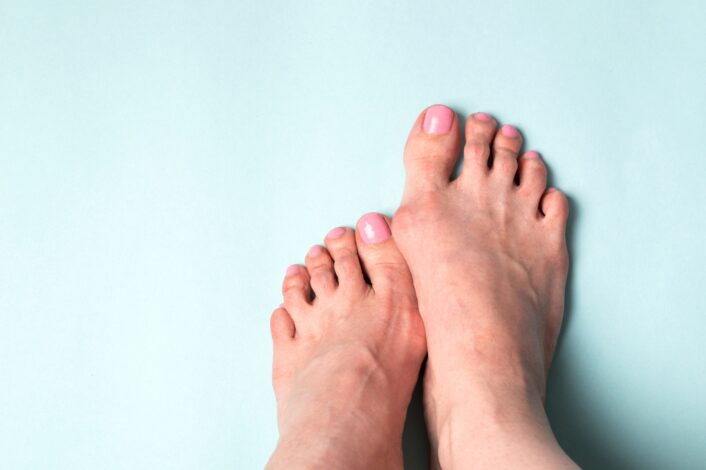

Disclaimer: This article is for informational purposes only and is not intended to diagnose any conditions. LifeDNA does not provide diagnostic services for any conditions mentioned in this or any other article.
Have you ever noticed a bony bump at the base of your big toe? This common foot deformity is known as a bunion or hallux valgus. The big toe anchors your foot, connecting to the first toe bone through the metatarsophalangeal (MTP) joint, which helps distribute your weight as you walk. When this joint develops a problem, the bones can shift out of alignment, causing the big toe to lean towards the smaller toes and the joint base to protrude, often leading to red, sore skin over the area.
Genetics play a significant role in bunions, with 70% of affected individuals having family members who also experience them. While bunions may appear early in life due to genetic predispositions, they often develop during adulthood. Factors such as repetitive minor injuries from wearing high-heeled or narrow-toed shoes may contribute to their formation. Bunions are more common in adults, particularly affecting women more than men.
The exact reasons for bunions aren’t fully known, but experts think both inherited traits and lifestyle choices are involved. Here are the possible genetic and environmental causes for bunions:
Inherited Factors and Foot Mechanics: Genetics may influence bunion development by shaping foot structures such as flat feet, low arches, or overly flexible joints and tendons. These inherited traits alter foot, leading to gradual misalignment of the big toe joint over time.
Congenital Deformities: Some individuals are born with foot deformities that predispose them to bunions. These congenital issues, such as abnormal bone shapes or joint structures, contribute to misalignment and bunion development from an early age.
Genetic dispositions to bunions are discussed more in detail further in this article.
Impact of Footwear: Wearing shoes that don’t fit well, particularly high heels or narrow-toed shoes, may worsen bunion risk. High heels push body weight forward, increasing pressure on the front of the foot and toes. Over time, this pressure can misalign the big toe joint and lead to bunion formation. Women are more susceptible, often due to their choice of footwear.
Arthritis and Bunion Development: Conditions like osteoarthritis and rheumatoid arthritis may contribute to bunion development by causing joint inflammation and cartilage breakdown. These factors may lead to pain, deformity, and instability in the MTP joint.
Foot Stress and Injuries: Repetitive stress or injuries to the foot, often from activities like ballet dancing, may increase the risk of bunion formation. Such injuries may destabilize the MTP joint, causing bones to shift out of place.
The signs and symptoms of a bunion include:
Bulging Bump: A noticeable bulge at the base of the big toe is the most common symptom of a bunion. This bony bump forms as the big toe joint becomes misaligned and may vary in size and severity, depending on the extent of the misalignment.
Swelling, Redness, or Soreness: The skin over the bunion may become swollen, red, and sore due to the constant pressure from shoes. Inflammation and irritation of the surrounding soft tissues may lead to discomfort and pain, especially when walking or wearing tight footwear.
Corns or Calluses: Corns or calluses may develop on the overlapping first and second toes due to the constant rubbing and pressure. These thickened layers of skin form as a protective response to the friction and may cause additional pain and discomfort.
Ongoing Pain: The pain can range from mild to severe and may be accompanied by a burning sensation or aching in the affected joint which may worsen with prolonged standing, walking, or wearing tight shoes.
Limited Movement: The misalignment and inflammation can make it difficult to bend or straighten the toe, affecting your overall foot function which may lead to restricted movement of the big toe joint.
A study involving patients and their family members with hallux valgus (HV), or bunions, was conducted in 2007 to understand its hereditary patterns. Over a year, 1174 patients with painful bunion deformities underwent X-ray imaging and filled out detailed family history forms. The proband consisted of350 individuals (22 men, 328 women; average age 47.8 years), with a ratio of about 1 man for every 15 women. They found that in the families of 244 out of the 350 patients, three or more members had HV; in 71 families, two members were affected;and in 35 families, only the patient themselves showed symptoms. The study observed that females were more likely to have parents and relatives affected by HV. However, the severity of HV did not significantly vary based on gender or affected family members. The presence of a family history of bunions in 90% of patients and the condition appearing across multiple generations suggests that HV may be inherited dominantly but not everyone with the genetic predisposition develops symptoms.
A more recent study of 2021 involved 10 participants from three independent families, including 7 individuals affected by HV and 3 unaffected, and used whole exome sequencing, a type of DNAsequencing currently used to understand the genetic causes of symptoms or diseases. The DNA analysis identified significant genetic factors linked to bunions. The study identified 36 different genes potentially associated with HV, including TTN, COL6A3, and LARS, which are known for their role in influencing the development of long toes and fingers. Additionally, genes like FIG4 and CBS, which are associated with digital anomalies, were highlighted. The C7 gene which was associated with bunions is also linked to chronic arthritis, and may contribute to HV by promoting inflammation.
Bunions are diagnosed through a physical examination, where your doctor will look for signs such as a noticeable bump at the base of your big toe, along with swelling, redness, soreness, and limitations in toe or foot movement. X-rays are commonly used to assess the severity of the condition and the alignment of bones.
Bunions may lead to several complications if left untreated, impacting the overall health and functionality of your feet. Here are some possible complications of bunions:
Bursitis: This condition is the inflammation of the small fluid-filled pads (bursa) that cushion the bones near joints. Bunions create extra pressure and friction at the joint of the big toe. Over time, this persistent stress can irritate and inflame the bursa. The inflammation of the bursa, known as bursitis, results in pain, swelling, and restricted movement in the affected area.
Hammertoe: This occurs when the middle joint of a toe, typically the second toe, bends abnormally, often due to the pressure from a bunion altering foot mechanics. Symptoms include a visible bend, pain, and corns or calluses from friction.
Metatarsalgia: Refers to pain and inflammation in the ball of the foot, often caused by the altered weight distribution due to a bunion. This condition results in sharp or aching pain, swelling, and a sensation of walking on a pebble.
Treatment options vary depending on the severity of your bunion and the pain it causes. These include both non surgical and surgical methods.
Nonsurgical treatments that may relieve the pain and pressure of a bunion include:
Changing shoes: Wear roomy, comfortable shoes that provide plenty of space for your toes.
Medications: Pain relief for bunions may often be managed with over-the-counter pain relievers and anti-inflammatory treatments to reduce pain and swelling. It is important to seek advice from a healthcare professional before starting any medication or treatment plan to ensure it is appropriate for your specific condition.
Shoe inserts: Padded shoe inserts may help distribute pressure evenly when you move your feet, reducing symptoms and preventing the bunion from getting worse.
Applying ice: Icing your bunion after you’ve been on your feet too long or if it becomes inflamed may help relieve soreness and swelling.
If non surgical treatment doesn’t relieve your symptoms, surgery might be necessary. Surgery is not recommended for cosmetic reasons but only when a bunion causes frequent pain or interferes with daily activities. There are various surgical procedures for bunions, which can be done as single procedures or in combination. These might involve:
Osteotomy: Involves cutting and realigning the bone of the big toe. The surgeon makes small cuts in the bones to shift them into the correct position, held together with screws or pins. This procedure is often combined with other techniques to correct the toe’s alignment.
Exostectomy: Involves removing the bony bump from the toe joint without performing an alignment. While this can reduce pain and improve shoe fit, it does not address the underlying cause of the bunion and is usually combined with other procedures for long-term correction.
Arthrodesis: Involves surgical fusion of the big toe joint, creating a permanent bond between the bones. This procedure is used for severe bunions, particularly in cases where arthritis affects the toe joint. It eliminates joint movement, reduces pain and corrects deformity.
Lapidus Procedure: This procedure addresses hypermobility in the joint, by stabilizing the foot and realigning the toe. It involves fusing the first metatarsal bone to the medial cuneiform bone to correct severe bunions and prevent recurrence
Resection Arthroplasty: Involves removing the damaged portion of the toe joint to create a flexible scar tissue joint. This procedure is less common and usually reserved for older patients or those with severe arthritis and poor bone quality.


